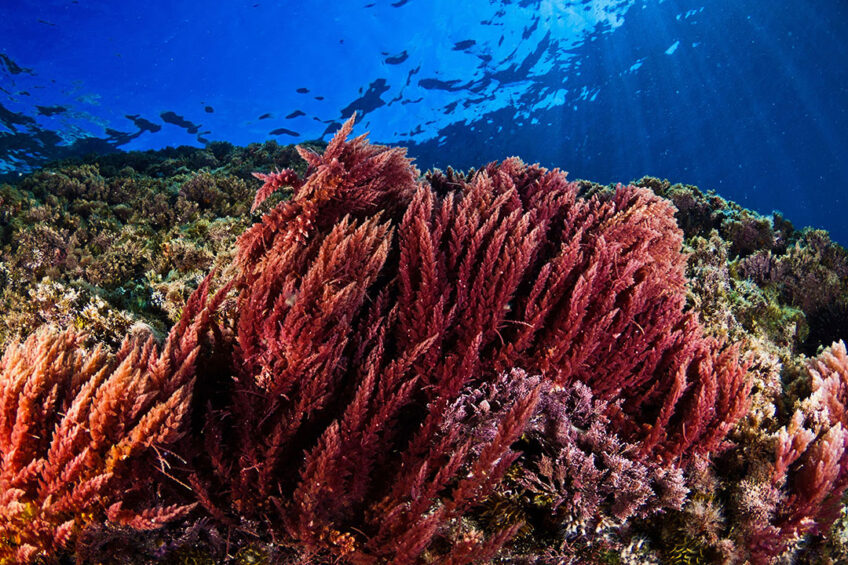Brown and green seaweeds in ruminant diets to reduce methane

Growing pressure on the livestock sector to cut methane levels from livestock are leading to an increasing number of studies looking at the effects of different seaweeds on ruminants.
Earlier this year, the first “low methane beef” was launched in Sweden by biotech start-up Volta Greentech, retailer Coop Sweden and food firm Protos. Coop offered a limited-edition run of ground beef, sirloin steak and beef fillets from cows that had been fed the red algae, “Asparagopsis taxiformis”.
Plans for large-scale seaweed factory
It followed a pilot at a commercial beef farm which showed emissions from its livestock were reduced by 81% when the company’s seaweed-based feed supplement was fed. The company plans to build its first large-scale seaweed factory – Volta Factory 02 – with a planned production of 50 tonnes of feed supplement per year.
Red seaweed: Human health concerns
But while scientists agree that the inclusion of the red seaweed “Asparagopsis taxiformis” as a feed additive, has led to a significant reduction in methane production, there are health issues to consider. Researchers from the Teagasc Animal and Bioscience Research and Food Departments, backed by University College Dublin and the University of Galway, say dietary supplementation with this seaweed is negatively associated with health and environmental concerns mainly due to its bromoform content, a compound with potential carcinogenic properties.
Renewed focus on brown & green seaweeds
As a result, there is a renewed focus on ascertaining the anti-methanogenic potential of locally grown brown and green seaweeds, which typically don’t contain bromoform. The objective of the study, led by Emily Roskam, was to investigate the effects of selected brown and green seaweeds on diet digestibility, ruminal fermentation patterns, total gas and methane production in vitro, using the rumen simulation technique system.
7 seaweeds studied
The scientists looked at Pelvetia canaliculate, a very common brown algae found on the rocks of the upper shores of Europe in the first experiment, before studying Cystoseira tamariscifolia (CYT), Bifucaria bifurcata (BIB); Fucus vesiculosis (FUV), Himanthalia elongate (HIM) and Ulva intestinalis (ULI). Ascophyllum nodosum (ASC) was included in both experiments. A diet containing A.taxiformis (ASP1; ASP2) and an unsupplemented diet (CON) were included as positive and negative controls in both experiments.
All seaweeds were included at a rate of 10g/kg dry matter (DM) into a control diet of 50:50 (w:w) forage:concentrate. The 7 brown and green seaweeds assessed failed to affect absolute methane emissions or alter fermentation patterns.
Experiment 1: seaweed treatment had no effect on diet digestibility, CH4%, CH4 mmol/d or CH4 L/D (P>0.1). However, ASP1 reduced CH4 mmol/g DOM by 49% (P<0.01) relative to the control. Both ASC and ASP1 tended to increase TGP relative to the control. In addition to this, the inclusion of seaweed in the first experiment reduced the production of NH3-N (P<0.001) compared to the control.
Experiment 2: seaweed inclusion had no effect on diet digestibility of TGP. Both ASP2 and FUV reduced methane but only ASP2 significantly reduced CH4 mmol.d, CH4 L/d and CH4 mmol/g DM (P<0.05). Daily mMol butyrate was reduced by ASP2 relative to the control and most other seaweeds (P<0.0001).
No impact on methane
In both experiments, seaweed inclusion had no effects on total daily VFA, acetate or propionate production of the acetate: propionate ratio relative to the control. In conclusion, the researchers said that including the bromoform-free brown and green seaweeds at 10g/DM had no negative effects on diet digestibility or fermentation patterns but also failed to reduce the production of enteric CH4 in vitro.
Results differed from previous study
The study came to a different conclusion compared to one published in the summer that was carried out by a German/Icelandic and UK research team into 2 brown Icelandic seaweed samples, including Fucus vesiculosis, which found supplementation of the seaweeds at a 5% inclusion level led to a decrease in methane concentration in the total gas due to the high iodine content in the seaweeds tested. That study concluded however by saying the application of practical feeding should be done with caution.
The research is part of 3 studies published in Frontiers of Animal Science – Frontiers | Effect of brown and green seaweeds on diet digestibility, ruminal fermentation patterns and enteric methane emissions using the rumen simulation technique (frontiersin.org)







